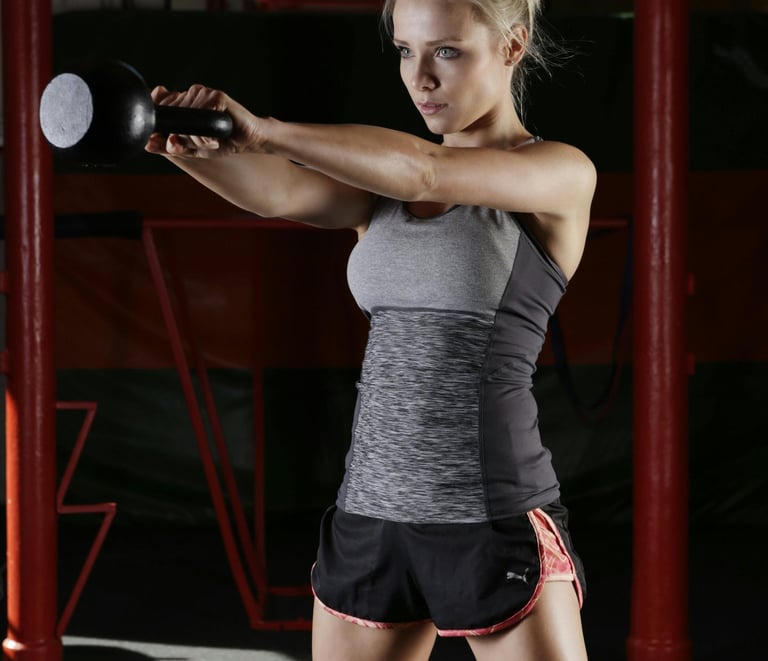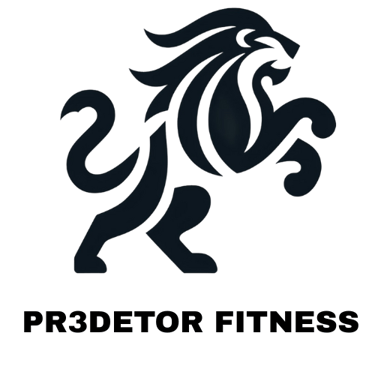Anatomy of a Power Move: Breaking Down Kettlebell Swings from the Inside Out
"Kettlebell Swing"
Coach Gabe
5/16/20257 min read


Introduction to Kettlebell Swings
Kettlebell swings have emerged as a quintessential exercise in contemporary strength training, renowned for their efficacy and versatility. This dynamic movement integrates multiple muscle groups, making it a favored choice among fitness enthusiasts and athletes who seek to enhance their power, strength, and cardiovascular fitness. The kettlebell, with its unique design, allows for a range of swinging motions that not only engage the lower body but also activate the core and upper body, promoting a comprehensive workout.
The growing popularity of kettlebell swings can be attributed to their ability to produce significant results in a relatively short period. As a compound exercise, kettlebell swings engage the glutes, hamstrings, and back, fostering enhanced power generation and muscular endurance. Additionally, the explosive nature of the swing contributes to improved cardiovascular health, making it an efficient choice for those looking to combine strength training with aerobic conditioning.
This blog post aims to delve into the anatomy and technique of kettlebell swings, providing readers with a thorough understanding of the mechanics involved in executing this powerful movement. By dissecting the various components of the kettlebell swing, we hope to equip both novices and seasoned practitioners with the insights necessary to perform the exercise safely and effectively. Understanding the intricacies of form, posture, and movement will not only optimize performance but also reduce the risk of injury, underscoring the importance of mastering this foundational exercise in any fitness regimen.
The Anatomy of Kettlebell Swings
Kettlebell swings are a compound exercise that engages multiple muscle groups, rendering them an effective choice for strength and conditioning. The primary muscle groups involved in executing a kettlebell swing include the glutes, hamstrings, core muscles, and shoulders, which together facilitate powerful and dynamic movement. The gluteus maximus is particularly crucial, as it serves as the major driver in the upward phase of the swing. When effectively activated, the glutes contribute to hip extension, enabling the lifter to propel the kettlebell forward and upward.
In terms of the lower body, the hamstrings also play a vital role in the kettlebell swing. These muscles work in concert with the glutes, providing necessary strength during the initial swing and stabilizing the pelvis throughout the movement. When both muscle groups operate efficiently, the result is an explosive hip drive that can enhance overall power and performance.
Core muscles, including the rectus abdominis and obliques, are equally important during kettlebell swings. A solid core stabilizes the spine and pelvis, preventing undue strain and promoting correct biomechanics while swinging. This stability allows for optimal power transfer from the lower body to the upper body, contributing to the effectiveness of the exercise.
Finally, the shoulders and upper back engage during the kettlebell swing, particularly in the peak extension phase. Muscles such as the deltoids and trapezius assist in controlling the kettlebell’s arc and maintaining proper posture. Together, these muscle groups create a cohesive, synergistic system that maximizes the effectiveness of kettlebell swings, highlighting their anatomical complexity and efficiency. Understanding these roles can enhance exercise performance and safety, leading to improved overall fitness outcomes.
Proper Kettlebell Grip and Setup
Establishing a proper kettlebell grip and setup is crucial for executing effective and safe kettlebell swings. The first step in this process is to ensure that your stance is stable and aligned. Begin by standing with your feet shoulder-width apart, allowing for a natural and balanced position. Your toes should be pointed slightly outward, creating a solid base that supports the movement. Ensuring a neutral spine alignment is paramount; this means your back should remain straight, and your shoulders should be relaxed yet engaged. Maintaining this position helps to avoid unnecessary strain on the lower back during the kettlebell swing.
When it comes to gripping the kettlebell, proper technique is key. To start, reach down and grasp the kettlebell by its handle, ensuring that your grip is firm but not overly tight, as excessive tension can lead to fatigue and possible injury. Your palms should be positioned facing your body, with thumbs wrapped around the handle to secure your hold. The kettlebell should rest against your wrist instead of hanging, which allows better control of the movement. Additionally, the stance should be of a slight bend in your knees, preparing your body to engage the hips as you begin the swing.
Moreover, before executing the kettlebell swing, it is essential to breathe properly. Inhale deeply before the downward phase and exhale powerfully as you initiate the swing, utilizing your core to stabilize your movement. By following these foundational steps—maintaining a neutral spine, ensuring a proper grip, and establishing a stable stance—you will set yourself up for success. These aspects contribute to both safety and efficacy during kettlebell swings, enhancing your performance and results while minimizing the risk of injury.
The Swing Mechanics: From Hinge to Lift
The kettlebell swing is a dynamic exercise that consists of three distinct phases: the hip hinge, the backswing, and the powerful lift. Understanding these mechanics is crucial for maximizing efficiency and effectiveness while minimizing the risk of injury. In this detailed breakdown, we will explore each phase and highlight the transitions necessary for optimal form.
Beginning with the hip hinge, this initial position is fundamental in establishing a strong foundation for the swing. To initiate the hip hinge, one must push the hips back while maintaining a neutral spine. This action should engage the hamstrings and glutes, preparing them for the explosive movement that follows. The kettlebell should be positioned a short distance in front of the body, emphasizing the need for the hips to drive backward rather than bending forward. This sets the stage for an effective swing, allowing the body's center of gravity to stay aligned.
Moving into the backswing, this phase involves swinging the kettlebell between the legs. As the kettlebell travels down, it is critical to keep the wrists neutral and the arms relaxed. The force generated from the hip hinge should initiate this movement, allowing the kettlebell to reach just behind the body. The timing of this phase is essential, as a well-executed backswing helps to build momentum that will be harnessed in the subsequent lift.
Finally, the powerful lift phase is where the explosive energy is unleashed. Transitioning from the backswing involves aggressively driving the hips forward, straightening the legs while simultaneously engaging the core. The kettlebell should be thrust forward and upward, utilizing the momentum created during the previous phases. It is essential to maintain a strong grip and posture throughout the lift to ensure the kettlebell's trajectory remains controlled, ultimately leading to a successful swing.
Each phase in kettlebell swinging plays a vital role in producing a cohesive and powerful exercise. Mastery of the swing mechanics not only enhances performance but also contributes to overall strength and conditioning.
Common Mistakes to Avoid
When performing kettlebell swings, individuals often make several common mistakes that can compromise both their safety and the effectiveness of the exercise. One significant error is poor posture, which manifests through an excessive arch in the lower back or rounded shoulders. This can lead to undue strain on the spine and increase the risk of injury. It is essential to maintain a neutral spine during the swing, engaging the core and ensuring the shoulders are retracted and relaxed.
Another frequent mistake involves improper weight distribution. Many individuals tend to place too much weight on their toes during the swing, which can cause instability and reduce the power generated from the hip drive. Ideally, the weight should be centered over the heels, allowing for a stronger connection to the ground and better mechanics as the kettlebell is propelled forward. Ensuring that the feet are firmly planted and that the grip on the kettlebell is secure can also help maintain proper weight distribution.
Lack of hip drive is also a critical error that can hinder the efficacy of kettlebell swings. Instead of utilizing the hips to generate momentum, individuals might rely on their arms to lift the weight, which is not the intended biomechanical movement. To correct this, it is vital to initiate the swing with a powerful hip thrust, allowing the kettlebell to swing through the legs and rise to shoulder height with minimal effort from the arms.
Incorporating visual representations of both incorrect and correct techniques can further assist individuals in understanding these common errors and their corrections. By emphasizing proper posture, weight distribution, and hip drive, practitioners can enhance their kettlebell swing, making it a safe and effective exercise within their fitness routines.
Incorporating Kettlebell Swings into Your Routine
Integrating kettlebell swings into a fitness routine can significantly enhance overall strength, conditioning, and endurance. Due to their versatile nature, these exercises can be tailored to accommodate different fitness levels, allowing both beginners and experienced athletes to benefit. For beginners, starting with two to three sets of eight to twelve repetitions of kettlebell swings is advisable. This approach allows for the development of proper form and technique while reducing the risk of injury.
As proficiency improves, individuals can gradually increase the load of the kettlebell or the number of sets and repetitions, advancing to three to five sets with twelve to twenty swings. For those adopting an intermediate or advanced regimen, kettlebell swings can be incorporated into high-intensity interval training (HIIT) sessions. By doing so, they not only challenge the musculoskeletal system but also promote metabolic conditioning. A typical HIIT session might include kettlebell swings paired with exercises like burpees or mountain climbers, performed in timed intervals for an effective workout.
Moreover, kettlebell swings can complement traditional strength training routines. For example, performing kettlebell swings prior to a leg or back workout stimulates the posterior chain, effectively warming up the muscles. This strategic sequencing prepares the body for subsequent strength exercises such as deadlifts or squats, often yielding better results. Variety is essential for progression; experimenting with different grip styles, such as one-handed swings or alternating swings, can introduce new challenges and prevent workout monotony.
Ultimately, the effective incorporation of kettlebell swings into a training regimen hinges on listening to one's body. This focus on progression and variation ensures a well-rounded approach, maximizing results while maintaining motivation throughout the fitness journey.
Conclusion and Final Thoughts
Throughout this blog post, we have explored the anatomy and mechanics of kettlebell swings, highlighting the vital components that contribute to this powerful exercise. The kettlebell swing is not merely a test of strength but also a demonstration of coordination, balance, and overall body awareness. By understanding the fundamental movements and engaging the correct muscle groups, practitioners can enhance their technique and reduce the risk of injury.
The emphasis on proper form cannot be overstated. Each element of the swing—from the hip hinge to the follow-through—plays an essential role in maximizing effectiveness while ensuring safety. Practicing with awareness allows individuals to fine-tune their execution, ultimately reaping the full benefits of this dynamic exercise. Whether you are a seasoned athlete or a novice, taking the time to analyze and improve your kettlebell swing form can lead to significant advancements in overall fitness.
I encourage readers to share their personal experiences with kettlebell swings in the comments section below. I would love to hear about the challenges you’ve faced, the tips that have helped you, or any other insights you may have gained through practice. Engaging with a community of fellow fitness enthusiasts can provide motivation and inspiration to enhance your skills. Remember, each kettlebell swing is an opportunity for improvement—a chance to master your technique and unlock the full potential of this remarkable exercise. So, keep swinging and continue your journey toward strength and fitness, one powerful move at a time.


